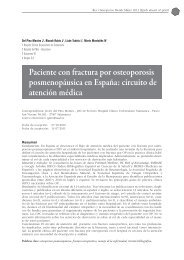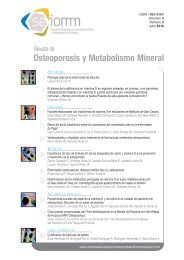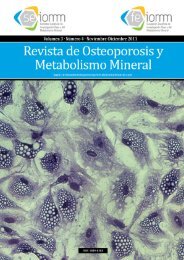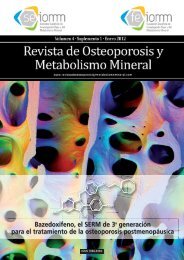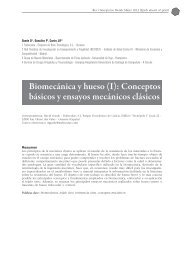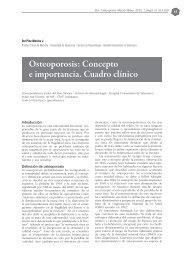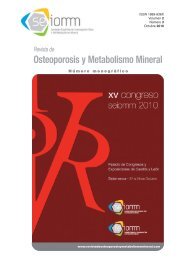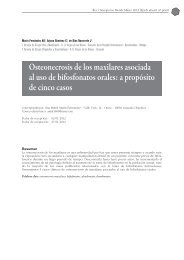Nº 1 Español - Revista de Osteoporosis y Metabolismo Mineral
Nº 1 Español - Revista de Osteoporosis y Metabolismo Mineral
Nº 1 Español - Revista de Osteoporosis y Metabolismo Mineral
You also want an ePaper? Increase the reach of your titles
YUMPU automatically turns print PDFs into web optimized ePapers that Google loves.
28<br />
REVISIÓN / Rev Osteoporos Metab Miner 2012 4;1:27-35<br />
Patient with fracture due to postmenopausal osteoporosis in<br />
Spain: medical care pathway<br />
Summary<br />
Background: In Spain, the flow of medical care for a patient with a fracture due to postmenopausal osteoporosis<br />
(PO) in the hospital system is not un<strong>de</strong>rstood. A literature review has been carried out in or<strong>de</strong>r<br />
to <strong>de</strong>fine the hospital care pathway for patients with fracture due to PO in normal clinical practice, taking<br />
into account the different medical specialisms involved. In addition, it was attempted to <strong>de</strong>termine the<br />
role of each specialist and the most common referral services.<br />
Material and methods: The databases PubMed/Medline, ISI Web of Knowledge, EMBASE and Google<br />
Scholar; IBECS (Spanish Bibliographical In<strong>de</strong>x in Health Sciences (Índice Bibliográfico Español en<br />
Ciencias <strong>de</strong> la Salud)) and MEDES (Medicine in Spanish (Medicina en Español)) were consulted, as well<br />
as the web pages of the Spanish Society of Rheumatology, the Spanish Society for Bone and <strong>Mineral</strong><br />
Metabolism Research, the Spanish Society of Orthopaedic Surgery and Traumatology, and the Spanish<br />
Association for the Study of the Menopause, to i<strong>de</strong>ntify publications appearing between 2000 and 2010<br />
in English or Spanish. The principal national clinical practice gui<strong>de</strong>s (CPG) for PO were reviewed.<br />
Results: A total of 114 articles were i<strong>de</strong>ntified. After discounting non-relevant publications, duplicate<br />
publications and those published in languages other than English or Spanish, 13 articles were selected.<br />
4 articles were exclu<strong>de</strong>d (n=2 screening for osteoporosis, n=1 risk factors, n=1 cost studies), with a total<br />
of 9 articles being reviewed. All the articles were international (n=9), including American (n=4), Canadian<br />
(n=2), Swiss (n=1), Irish (n=1) and multinational (n=1), and <strong>de</strong>scribed the outpatient management of fractures<br />
due to PO mainly in the extra-hospital environment. Notable in this environment is the essential<br />
role of the orthopaedic surgeon and the need for their coordination with family doctors to guarantee the<br />
optimum follow up of patients and the prevention of second fractures. The CPGs reviewed referred only<br />
to the diagnosis and therapeutic management of the patient with PO. No information was found on referral<br />
services, or on the role of each specialist in the management of these patients.<br />
Conclusions: The care pathway for patients with osteoporotic fracture, and which professionals are involved,<br />
are poorly <strong>de</strong>scribed in the literature, both nationally and internationally. The clinical management<br />
of patients with fracture due to osteoporosis in hospitals is an area of healthcare which needs <strong>de</strong>scription<br />
and analysis.<br />
Key words: postmenopausal osteoporosis, osteoporotic fracture, management of the disease, bibliographical review.<br />
Introducción<br />
La osteoporosis es una enfermedad caracterizada<br />
por una disminución <strong>de</strong> la masa ósea y alteraciones<br />
<strong>de</strong> la microarquitectura <strong>de</strong>l tejido <strong>de</strong>l hueso,<br />
que conducen a un incremento <strong>de</strong> la fragilidad y,<br />
consecuentemente, a un riesgo elevado <strong>de</strong> presentar<br />
fracturas 1 . Éstas pue<strong>de</strong>n darse en cualquier zona<br />
<strong>de</strong>l esqueleto, aunque los lugares más afectados<br />
son la columna vertebral, el radio distal (fractura<br />
<strong>de</strong> Colles) y la ca<strong>de</strong>ra 2 . Se ha estimado que una<br />
mujer <strong>de</strong> 50 años tiene un riesgo <strong>de</strong>l 40% <strong>de</strong> sufrir<br />
una fractura durante el resto <strong>de</strong> su vida, mientras<br />
que en los varones el riesgo alcanza el 13% 2 .<br />
La osteoporosis es la enfermedad ósea más<br />
prevalente, afectando a un 35% <strong>de</strong> mujeres españolas<br />
<strong>de</strong> más <strong>de</strong> 50 años, porcentaje que se eleva<br />
a un 52% en las mayores <strong>de</strong> 70 años 3 . Una <strong>de</strong> cada<br />
5 mujeres con edad superior a los 50 años tiene al<br />
menos una fractura vertebral <strong>de</strong>bida a la osteoporosis,<br />
que se asocia a un <strong>de</strong>terioro <strong>de</strong> la calidad <strong>de</strong><br />
vida relacionada con la salud y a un riesgo aumentado<br />
<strong>de</strong> sufrir otras fracturas. La inci<strong>de</strong>ncia anual<br />
<strong>de</strong> fractura <strong>de</strong> fémur en mujeres <strong>de</strong> edad superior<br />
a 50 años es <strong>de</strong> 3 por 1.000, mientras que la inci<strong>de</strong>ncia<br />
<strong>de</strong> fractura <strong>de</strong> antebrazo distal es <strong>de</strong> casi el<br />
doble 3 . En España se producen 90.000 fracturas <strong>de</strong><br />
ca<strong>de</strong>ra y 500.000 fracturas vertebrales al año ligadas<br />
a la osteoporosis, según indica la Sociedad<br />
Española <strong>de</strong> Reumatología (SER) en el III<br />
Documento <strong>de</strong> <strong>Osteoporosis</strong> 4 . La inci<strong>de</strong>ncia <strong>de</strong><br />
fractura <strong>de</strong> ca<strong>de</strong>ra en España oscila, según la<br />
región estudiada, entre 34,9 y 83 fracturas por<br />
100.000 habitantes 5 .<br />
Según una encuesta dirigida fundamentalmente<br />
al ámbito ambulatorio sobre el manejo <strong>de</strong> recursos<br />
en la osteoporosis, encontramos que los profesionales<br />
implicados en el tratamiento <strong>de</strong> la<br />
misma incluyen, entre otros, a los reumatólogos,<br />
endocrinólogos y traumatólogos 6 . Concretamente,<br />
cabe <strong>de</strong>stacar el papel <strong>de</strong>l endocrinólogo y <strong>de</strong>l<br />
traumatólogo en el diagnóstico <strong>de</strong> la misma,<br />
haciendo especial hincapié en el papel <strong>de</strong> este<br />
último tras la aparición <strong>de</strong> las primeras fracturas.<br />
El ginecólogo y el médico internista, por su parte,<br />
cumplen un papel fundamental en el diagnóstico<br />
<strong>de</strong> la osteoporosis postmenopáusica (OP).<br />
Desconocemos, sin embargo, el papel <strong>de</strong> éstos y<br />
otros especialistas en el manejo <strong>de</strong>l paciente con<br />
fractura por OP postmenopáusica en el ámbito<br />
hospitalario, y cómo se vinculan cada uno <strong>de</strong> ellos<br />
en el flujo <strong>de</strong> atención médica <strong>de</strong> este grupo <strong>de</strong><br />
pacientes en España.




